Financial Accounting and Reporting: Analyzing IFRS 16 Impact
VerifiedAdded on 2023/06/14
|10
|2420
|211
Report
AI Summary
This report comprehensively examines the impact of the new lease standard IFRS 16 on financial reporting for both lessees and lessors, highlighting its implications across various industries. It details the rationale behind the introduction of IFRS 16, which aims to provide a more accurate representation of liabilities and assets on financial statements by bringing most leases onto the balance sheet. The report discusses the effects on lessees, including changes in financial ratios, IT systems, and decision-making processes, while noting that lessor accounting remains largely unchanged but will experience shifts in business models due to customer behavior. Specific industries such as retailers, transport and logistics, and telecommunications are analyzed to demonstrate the diverse impacts of the new standard, concluding that while IFRS 16 will significantly alter lease accounting, its ultimate effect depends on the specific circumstances of each entity. Desklib provides access to this document and numerous other resources to aid students in their studies.
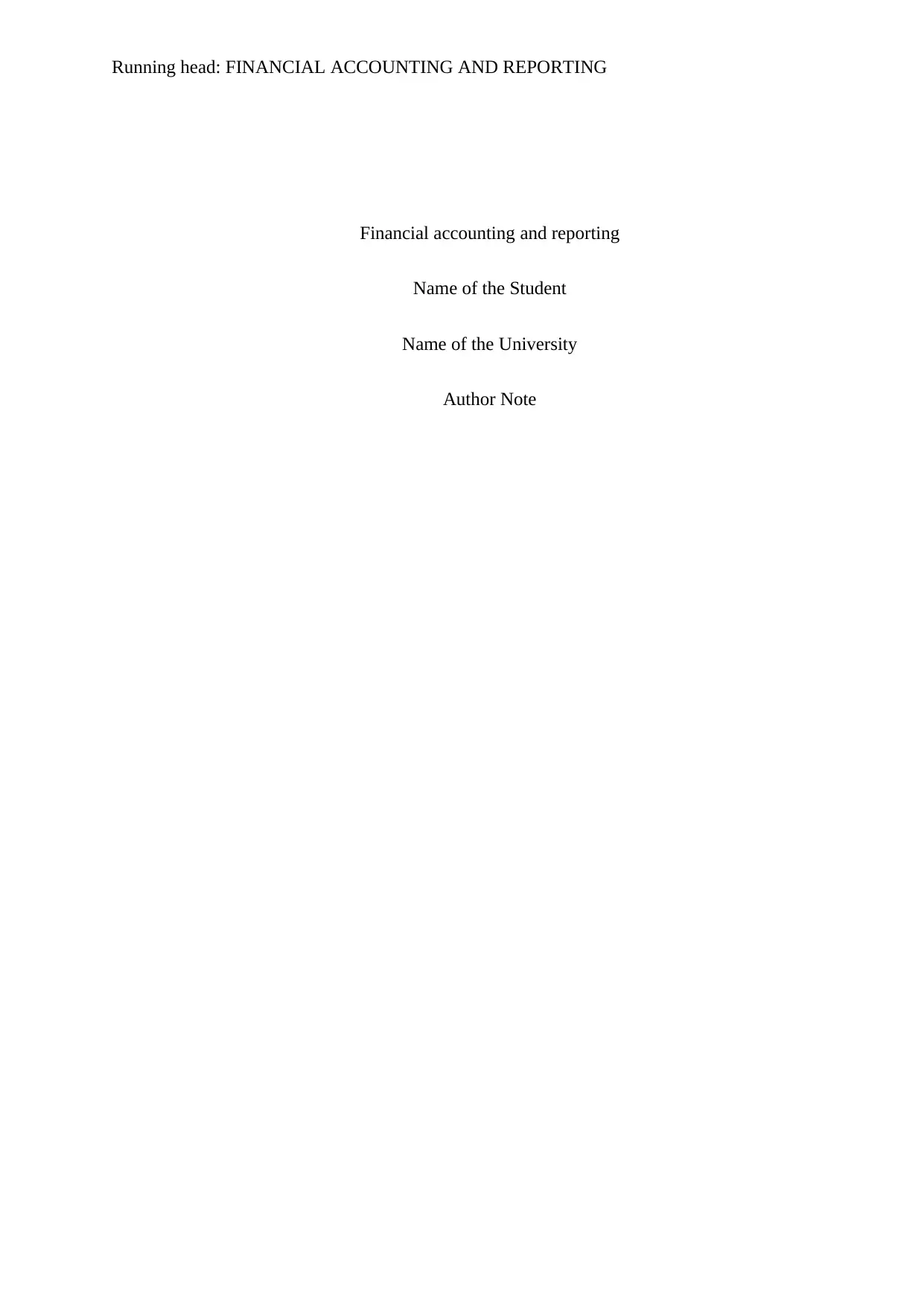
Running head: FINANCIAL ACCOUNTING AND REPORTING
Financial accounting and reporting
Name of the Student
Name of the University
Author Note
Financial accounting and reporting
Name of the Student
Name of the University
Author Note
Paraphrase This Document
Need a fresh take? Get an instant paraphrase of this document with our AI Paraphraser

1FINANCIAL ACCOUNTING AND REPORTING
Table of Contents
Introduction:...............................................................................................................................2
Rationale behind the introduction of new lease standard IFRS 16:...........................................2
Implication of new lease standard for lessee and lessors:..........................................................3
Types of companies that is likely to be affected by the new lease standard:.............................5
Conclusion:................................................................................................................................7
References list:...........................................................................................................................8
Table of Contents
Introduction:...............................................................................................................................2
Rationale behind the introduction of new lease standard IFRS 16:...........................................2
Implication of new lease standard for lessee and lessors:..........................................................3
Types of companies that is likely to be affected by the new lease standard:.............................5
Conclusion:................................................................................................................................7
References list:...........................................................................................................................8
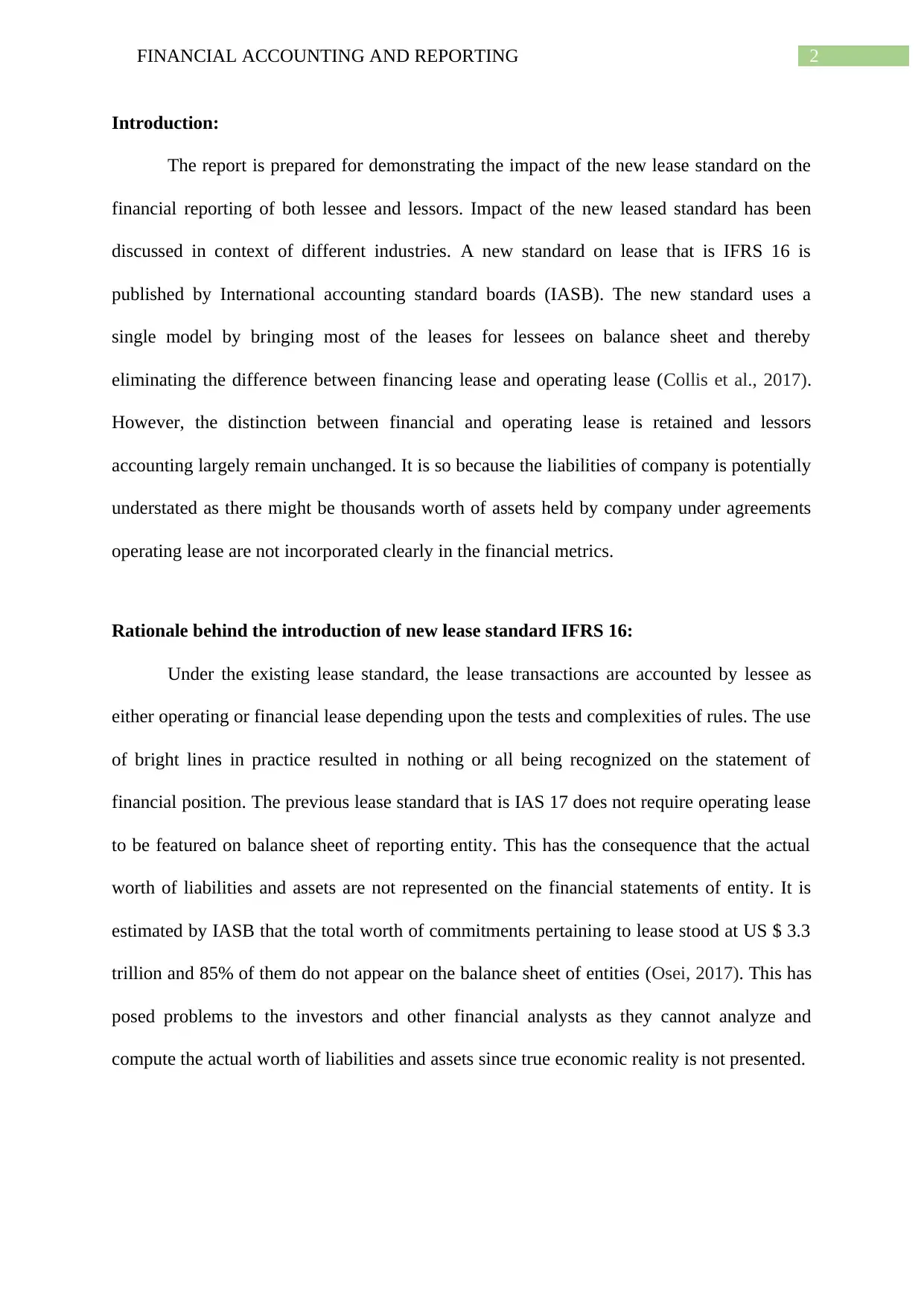
2FINANCIAL ACCOUNTING AND REPORTING
Introduction:
The report is prepared for demonstrating the impact of the new lease standard on the
financial reporting of both lessee and lessors. Impact of the new leased standard has been
discussed in context of different industries. A new standard on lease that is IFRS 16 is
published by International accounting standard boards (IASB). The new standard uses a
single model by bringing most of the leases for lessees on balance sheet and thereby
eliminating the difference between financing lease and operating lease (Collis et al., 2017).
However, the distinction between financial and operating lease is retained and lessors
accounting largely remain unchanged. It is so because the liabilities of company is potentially
understated as there might be thousands worth of assets held by company under agreements
operating lease are not incorporated clearly in the financial metrics.
Rationale behind the introduction of new lease standard IFRS 16:
Under the existing lease standard, the lease transactions are accounted by lessee as
either operating or financial lease depending upon the tests and complexities of rules. The use
of bright lines in practice resulted in nothing or all being recognized on the statement of
financial position. The previous lease standard that is IAS 17 does not require operating lease
to be featured on balance sheet of reporting entity. This has the consequence that the actual
worth of liabilities and assets are not represented on the financial statements of entity. It is
estimated by IASB that the total worth of commitments pertaining to lease stood at US $ 3.3
trillion and 85% of them do not appear on the balance sheet of entities (Osei, 2017). This has
posed problems to the investors and other financial analysts as they cannot analyze and
compute the actual worth of liabilities and assets since true economic reality is not presented.
Introduction:
The report is prepared for demonstrating the impact of the new lease standard on the
financial reporting of both lessee and lessors. Impact of the new leased standard has been
discussed in context of different industries. A new standard on lease that is IFRS 16 is
published by International accounting standard boards (IASB). The new standard uses a
single model by bringing most of the leases for lessees on balance sheet and thereby
eliminating the difference between financing lease and operating lease (Collis et al., 2017).
However, the distinction between financial and operating lease is retained and lessors
accounting largely remain unchanged. It is so because the liabilities of company is potentially
understated as there might be thousands worth of assets held by company under agreements
operating lease are not incorporated clearly in the financial metrics.
Rationale behind the introduction of new lease standard IFRS 16:
Under the existing lease standard, the lease transactions are accounted by lessee as
either operating or financial lease depending upon the tests and complexities of rules. The use
of bright lines in practice resulted in nothing or all being recognized on the statement of
financial position. The previous lease standard that is IAS 17 does not require operating lease
to be featured on balance sheet of reporting entity. This has the consequence that the actual
worth of liabilities and assets are not represented on the financial statements of entity. It is
estimated by IASB that the total worth of commitments pertaining to lease stood at US $ 3.3
trillion and 85% of them do not appear on the balance sheet of entities (Osei, 2017). This has
posed problems to the investors and other financial analysts as they cannot analyze and
compute the actual worth of liabilities and assets since true economic reality is not presented.
⊘ This is a preview!⊘
Do you want full access?
Subscribe today to unlock all pages.

Trusted by 1+ million students worldwide
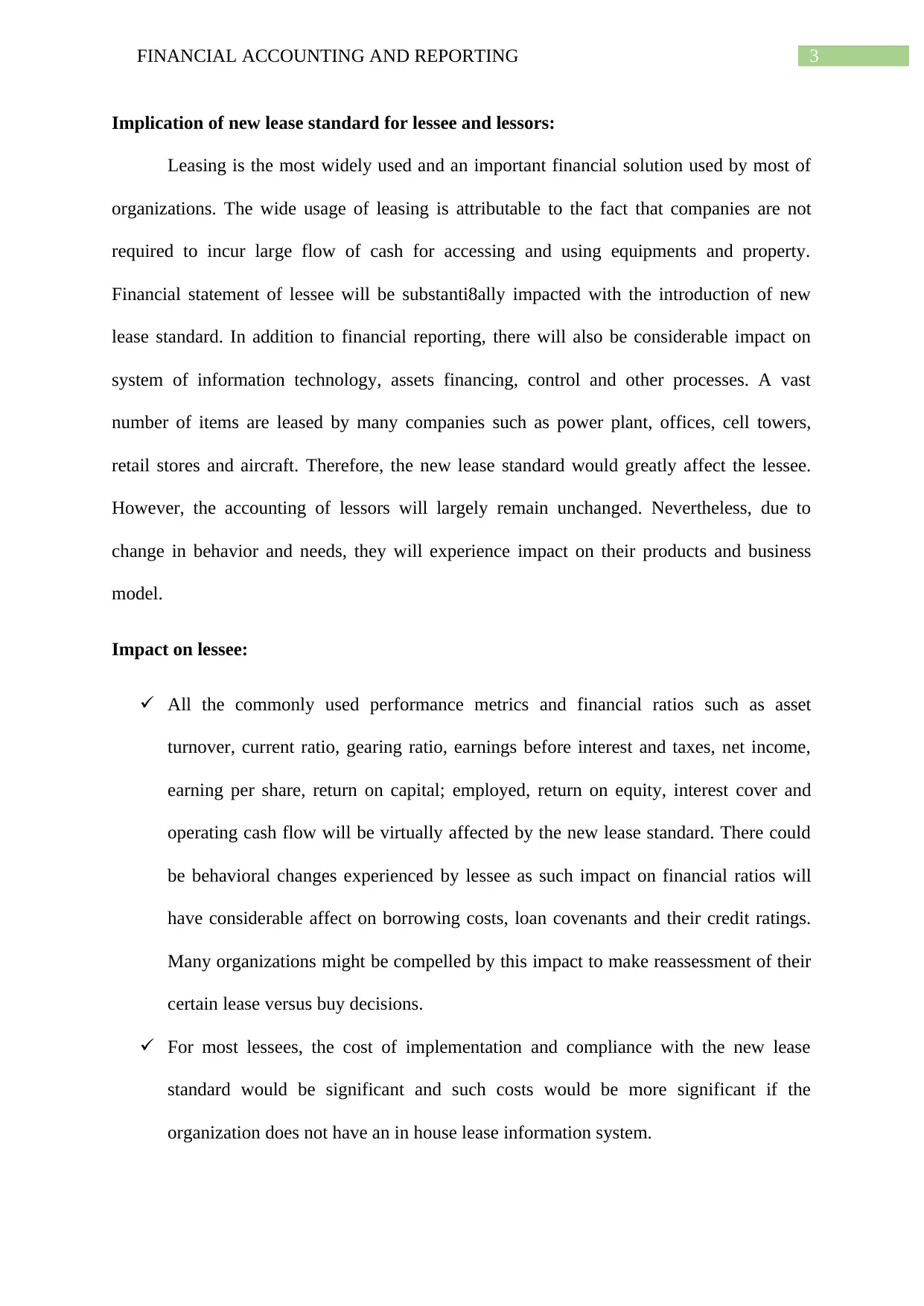
3FINANCIAL ACCOUNTING AND REPORTING
Implication of new lease standard for lessee and lessors:
Leasing is the most widely used and an important financial solution used by most of
organizations. The wide usage of leasing is attributable to the fact that companies are not
required to incur large flow of cash for accessing and using equipments and property.
Financial statement of lessee will be substanti8ally impacted with the introduction of new
lease standard. In addition to financial reporting, there will also be considerable impact on
system of information technology, assets financing, control and other processes. A vast
number of items are leased by many companies such as power plant, offices, cell towers,
retail stores and aircraft. Therefore, the new lease standard would greatly affect the lessee.
However, the accounting of lessors will largely remain unchanged. Nevertheless, due to
change in behavior and needs, they will experience impact on their products and business
model.
Impact on lessee:
All the commonly used performance metrics and financial ratios such as asset
turnover, current ratio, gearing ratio, earnings before interest and taxes, net income,
earning per share, return on capital; employed, return on equity, interest cover and
operating cash flow will be virtually affected by the new lease standard. There could
be behavioral changes experienced by lessee as such impact on financial ratios will
have considerable affect on borrowing costs, loan covenants and their credit ratings.
Many organizations might be compelled by this impact to make reassessment of their
certain lease versus buy decisions.
For most lessees, the cost of implementation and compliance with the new lease
standard would be significant and such costs would be more significant if the
organization does not have an in house lease information system.
Implication of new lease standard for lessee and lessors:
Leasing is the most widely used and an important financial solution used by most of
organizations. The wide usage of leasing is attributable to the fact that companies are not
required to incur large flow of cash for accessing and using equipments and property.
Financial statement of lessee will be substanti8ally impacted with the introduction of new
lease standard. In addition to financial reporting, there will also be considerable impact on
system of information technology, assets financing, control and other processes. A vast
number of items are leased by many companies such as power plant, offices, cell towers,
retail stores and aircraft. Therefore, the new lease standard would greatly affect the lessee.
However, the accounting of lessors will largely remain unchanged. Nevertheless, due to
change in behavior and needs, they will experience impact on their products and business
model.
Impact on lessee:
All the commonly used performance metrics and financial ratios such as asset
turnover, current ratio, gearing ratio, earnings before interest and taxes, net income,
earning per share, return on capital; employed, return on equity, interest cover and
operating cash flow will be virtually affected by the new lease standard. There could
be behavioral changes experienced by lessee as such impact on financial ratios will
have considerable affect on borrowing costs, loan covenants and their credit ratings.
Many organizations might be compelled by this impact to make reassessment of their
certain lease versus buy decisions.
For most lessees, the cost of implementation and compliance with the new lease
standard would be significant and such costs would be more significant if the
organization does not have an in house lease information system.
Paraphrase This Document
Need a fresh take? Get an instant paraphrase of this document with our AI Paraphraser
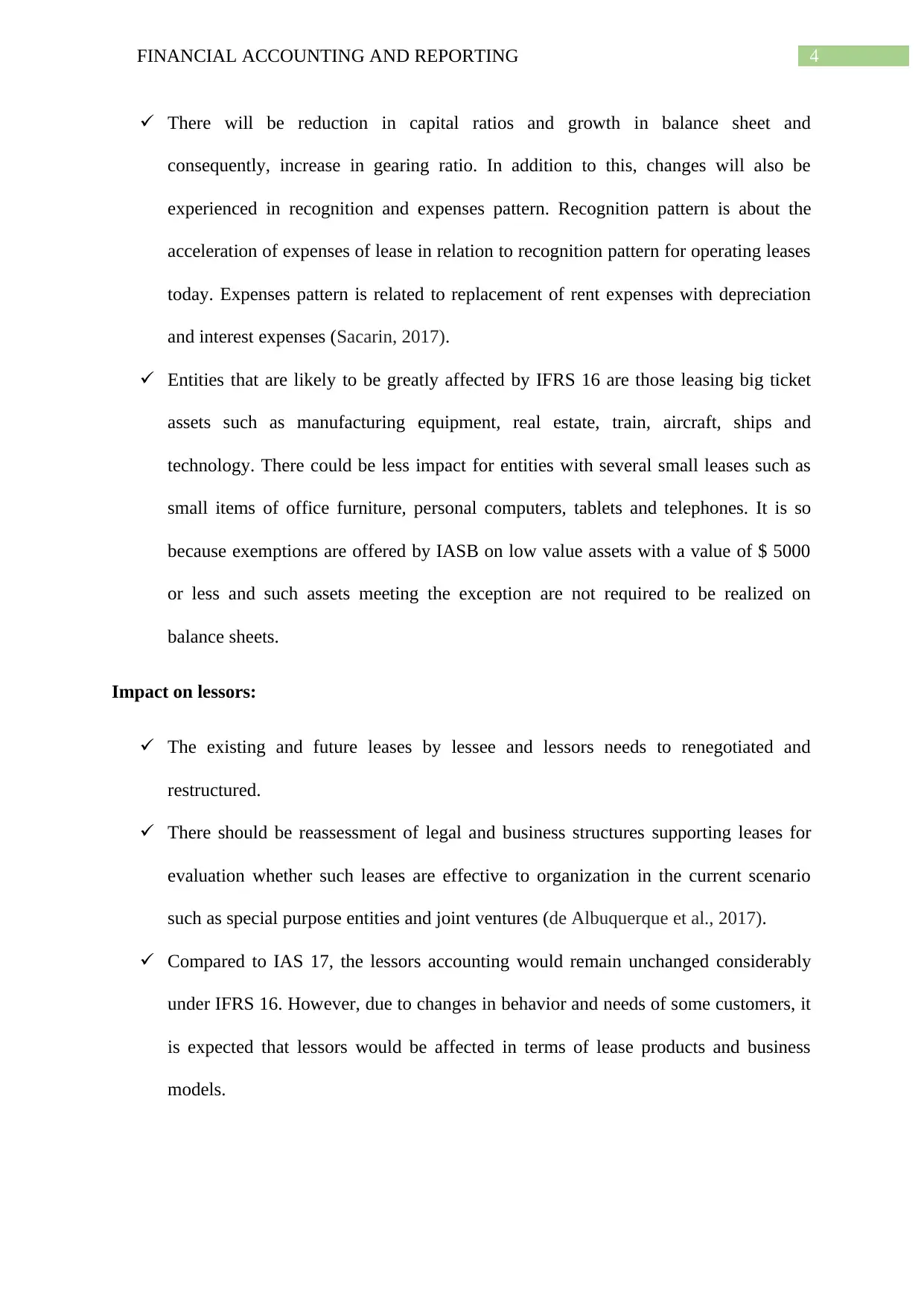
4FINANCIAL ACCOUNTING AND REPORTING
There will be reduction in capital ratios and growth in balance sheet and
consequently, increase in gearing ratio. In addition to this, changes will also be
experienced in recognition and expenses pattern. Recognition pattern is about the
acceleration of expenses of lease in relation to recognition pattern for operating leases
today. Expenses pattern is related to replacement of rent expenses with depreciation
and interest expenses (Sacarin, 2017).
Entities that are likely to be greatly affected by IFRS 16 are those leasing big ticket
assets such as manufacturing equipment, real estate, train, aircraft, ships and
technology. There could be less impact for entities with several small leases such as
small items of office furniture, personal computers, tablets and telephones. It is so
because exemptions are offered by IASB on low value assets with a value of $ 5000
or less and such assets meeting the exception are not required to be realized on
balance sheets.
Impact on lessors:
The existing and future leases by lessee and lessors needs to renegotiated and
restructured.
There should be reassessment of legal and business structures supporting leases for
evaluation whether such leases are effective to organization in the current scenario
such as special purpose entities and joint ventures (de Albuquerque et al., 2017).
Compared to IAS 17, the lessors accounting would remain unchanged considerably
under IFRS 16. However, due to changes in behavior and needs of some customers, it
is expected that lessors would be affected in terms of lease products and business
models.
There will be reduction in capital ratios and growth in balance sheet and
consequently, increase in gearing ratio. In addition to this, changes will also be
experienced in recognition and expenses pattern. Recognition pattern is about the
acceleration of expenses of lease in relation to recognition pattern for operating leases
today. Expenses pattern is related to replacement of rent expenses with depreciation
and interest expenses (Sacarin, 2017).
Entities that are likely to be greatly affected by IFRS 16 are those leasing big ticket
assets such as manufacturing equipment, real estate, train, aircraft, ships and
technology. There could be less impact for entities with several small leases such as
small items of office furniture, personal computers, tablets and telephones. It is so
because exemptions are offered by IASB on low value assets with a value of $ 5000
or less and such assets meeting the exception are not required to be realized on
balance sheets.
Impact on lessors:
The existing and future leases by lessee and lessors needs to renegotiated and
restructured.
There should be reassessment of legal and business structures supporting leases for
evaluation whether such leases are effective to organization in the current scenario
such as special purpose entities and joint ventures (de Albuquerque et al., 2017).
Compared to IAS 17, the lessors accounting would remain unchanged considerably
under IFRS 16. However, due to changes in behavior and needs of some customers, it
is expected that lessors would be affected in terms of lease products and business
models.
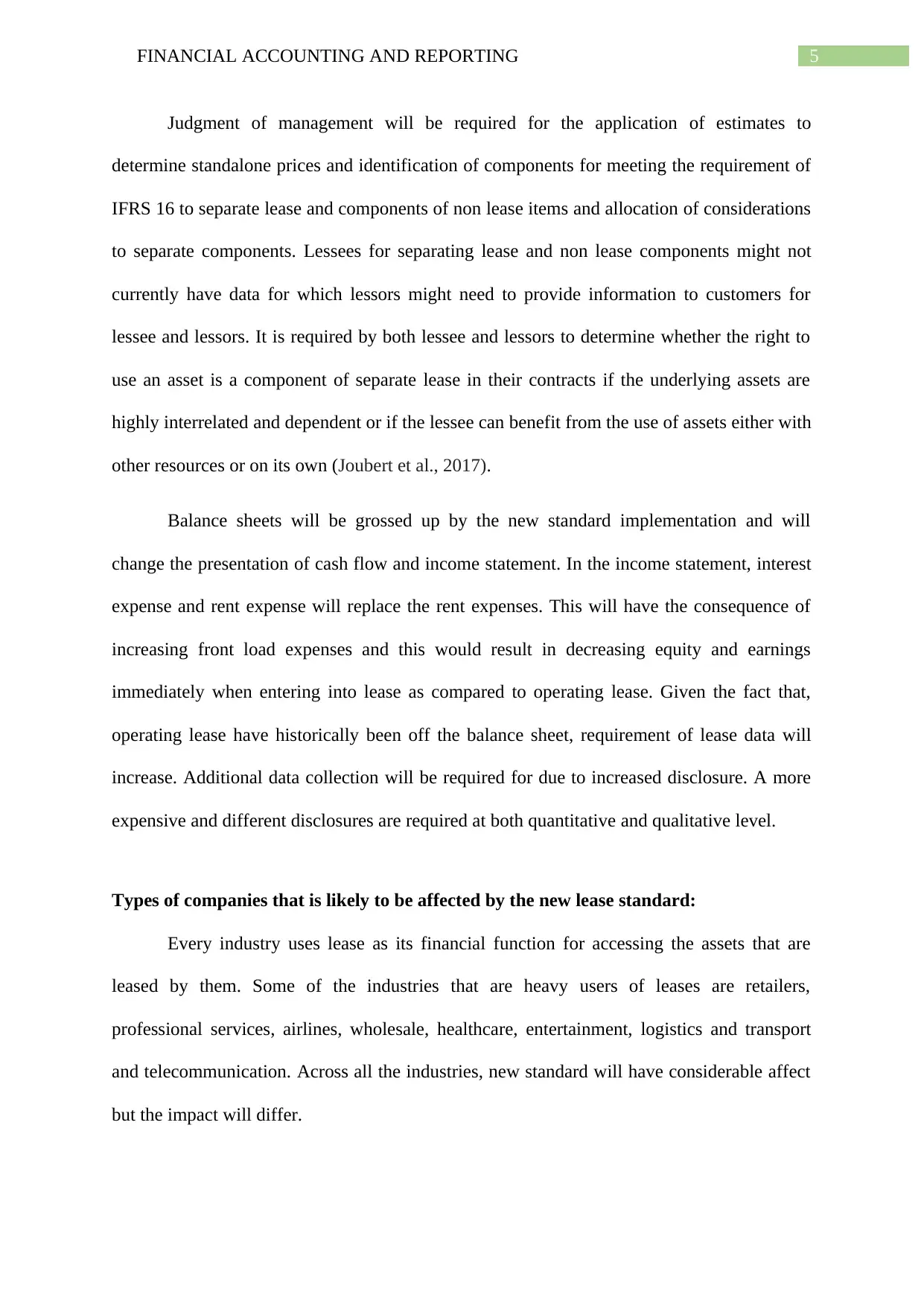
5FINANCIAL ACCOUNTING AND REPORTING
Judgment of management will be required for the application of estimates to
determine standalone prices and identification of components for meeting the requirement of
IFRS 16 to separate lease and components of non lease items and allocation of considerations
to separate components. Lessees for separating lease and non lease components might not
currently have data for which lessors might need to provide information to customers for
lessee and lessors. It is required by both lessee and lessors to determine whether the right to
use an asset is a component of separate lease in their contracts if the underlying assets are
highly interrelated and dependent or if the lessee can benefit from the use of assets either with
other resources or on its own (Joubert et al., 2017).
Balance sheets will be grossed up by the new standard implementation and will
change the presentation of cash flow and income statement. In the income statement, interest
expense and rent expense will replace the rent expenses. This will have the consequence of
increasing front load expenses and this would result in decreasing equity and earnings
immediately when entering into lease as compared to operating lease. Given the fact that,
operating lease have historically been off the balance sheet, requirement of lease data will
increase. Additional data collection will be required for due to increased disclosure. A more
expensive and different disclosures are required at both quantitative and qualitative level.
Types of companies that is likely to be affected by the new lease standard:
Every industry uses lease as its financial function for accessing the assets that are
leased by them. Some of the industries that are heavy users of leases are retailers,
professional services, airlines, wholesale, healthcare, entertainment, logistics and transport
and telecommunication. Across all the industries, new standard will have considerable affect
but the impact will differ.
Judgment of management will be required for the application of estimates to
determine standalone prices and identification of components for meeting the requirement of
IFRS 16 to separate lease and components of non lease items and allocation of considerations
to separate components. Lessees for separating lease and non lease components might not
currently have data for which lessors might need to provide information to customers for
lessee and lessors. It is required by both lessee and lessors to determine whether the right to
use an asset is a component of separate lease in their contracts if the underlying assets are
highly interrelated and dependent or if the lessee can benefit from the use of assets either with
other resources or on its own (Joubert et al., 2017).
Balance sheets will be grossed up by the new standard implementation and will
change the presentation of cash flow and income statement. In the income statement, interest
expense and rent expense will replace the rent expenses. This will have the consequence of
increasing front load expenses and this would result in decreasing equity and earnings
immediately when entering into lease as compared to operating lease. Given the fact that,
operating lease have historically been off the balance sheet, requirement of lease data will
increase. Additional data collection will be required for due to increased disclosure. A more
expensive and different disclosures are required at both quantitative and qualitative level.
Types of companies that is likely to be affected by the new lease standard:
Every industry uses lease as its financial function for accessing the assets that are
leased by them. Some of the industries that are heavy users of leases are retailers,
professional services, airlines, wholesale, healthcare, entertainment, logistics and transport
and telecommunication. Across all the industries, new standard will have considerable affect
but the impact will differ.
⊘ This is a preview!⊘
Do you want full access?
Subscribe today to unlock all pages.

Trusted by 1+ million students worldwide
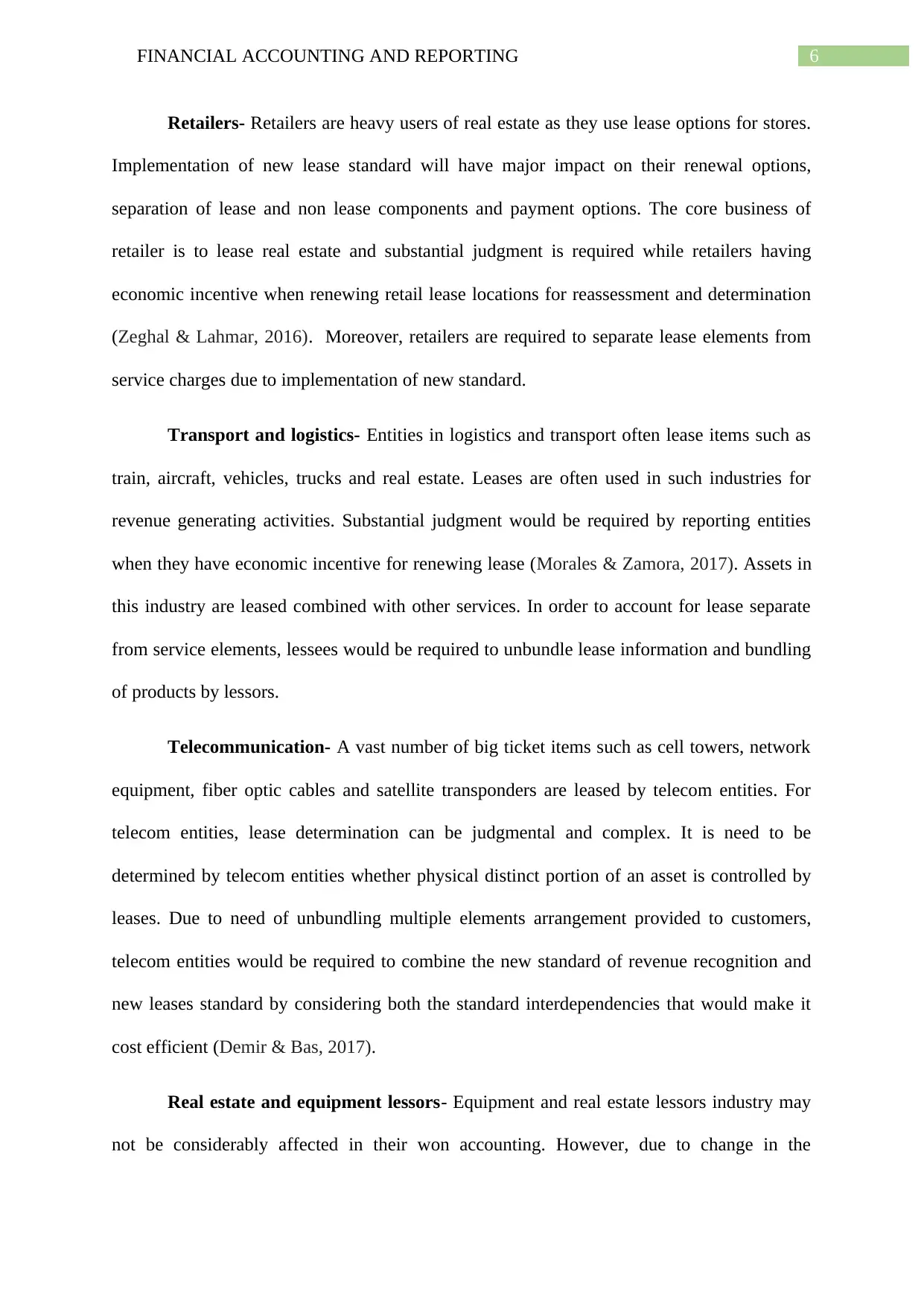
6FINANCIAL ACCOUNTING AND REPORTING
Retailers- Retailers are heavy users of real estate as they use lease options for stores.
Implementation of new lease standard will have major impact on their renewal options,
separation of lease and non lease components and payment options. The core business of
retailer is to lease real estate and substantial judgment is required while retailers having
economic incentive when renewing retail lease locations for reassessment and determination
(Zeghal & Lahmar, 2016). Moreover, retailers are required to separate lease elements from
service charges due to implementation of new standard.
Transport and logistics- Entities in logistics and transport often lease items such as
train, aircraft, vehicles, trucks and real estate. Leases are often used in such industries for
revenue generating activities. Substantial judgment would be required by reporting entities
when they have economic incentive for renewing lease (Morales & Zamora, 2017). Assets in
this industry are leased combined with other services. In order to account for lease separate
from service elements, lessees would be required to unbundle lease information and bundling
of products by lessors.
Telecommunication- A vast number of big ticket items such as cell towers, network
equipment, fiber optic cables and satellite transponders are leased by telecom entities. For
telecom entities, lease determination can be judgmental and complex. It is need to be
determined by telecom entities whether physical distinct portion of an asset is controlled by
leases. Due to need of unbundling multiple elements arrangement provided to customers,
telecom entities would be required to combine the new standard of revenue recognition and
new leases standard by considering both the standard interdependencies that would make it
cost efficient (Demir & Bas, 2017).
Real estate and equipment lessors- Equipment and real estate lessors industry may
not be considerably affected in their won accounting. However, due to change in the
Retailers- Retailers are heavy users of real estate as they use lease options for stores.
Implementation of new lease standard will have major impact on their renewal options,
separation of lease and non lease components and payment options. The core business of
retailer is to lease real estate and substantial judgment is required while retailers having
economic incentive when renewing retail lease locations for reassessment and determination
(Zeghal & Lahmar, 2016). Moreover, retailers are required to separate lease elements from
service charges due to implementation of new standard.
Transport and logistics- Entities in logistics and transport often lease items such as
train, aircraft, vehicles, trucks and real estate. Leases are often used in such industries for
revenue generating activities. Substantial judgment would be required by reporting entities
when they have economic incentive for renewing lease (Morales & Zamora, 2017). Assets in
this industry are leased combined with other services. In order to account for lease separate
from service elements, lessees would be required to unbundle lease information and bundling
of products by lessors.
Telecommunication- A vast number of big ticket items such as cell towers, network
equipment, fiber optic cables and satellite transponders are leased by telecom entities. For
telecom entities, lease determination can be judgmental and complex. It is need to be
determined by telecom entities whether physical distinct portion of an asset is controlled by
leases. Due to need of unbundling multiple elements arrangement provided to customers,
telecom entities would be required to combine the new standard of revenue recognition and
new leases standard by considering both the standard interdependencies that would make it
cost efficient (Demir & Bas, 2017).
Real estate and equipment lessors- Equipment and real estate lessors industry may
not be considerably affected in their won accounting. However, due to change in the
Paraphrase This Document
Need a fresh take? Get an instant paraphrase of this document with our AI Paraphraser
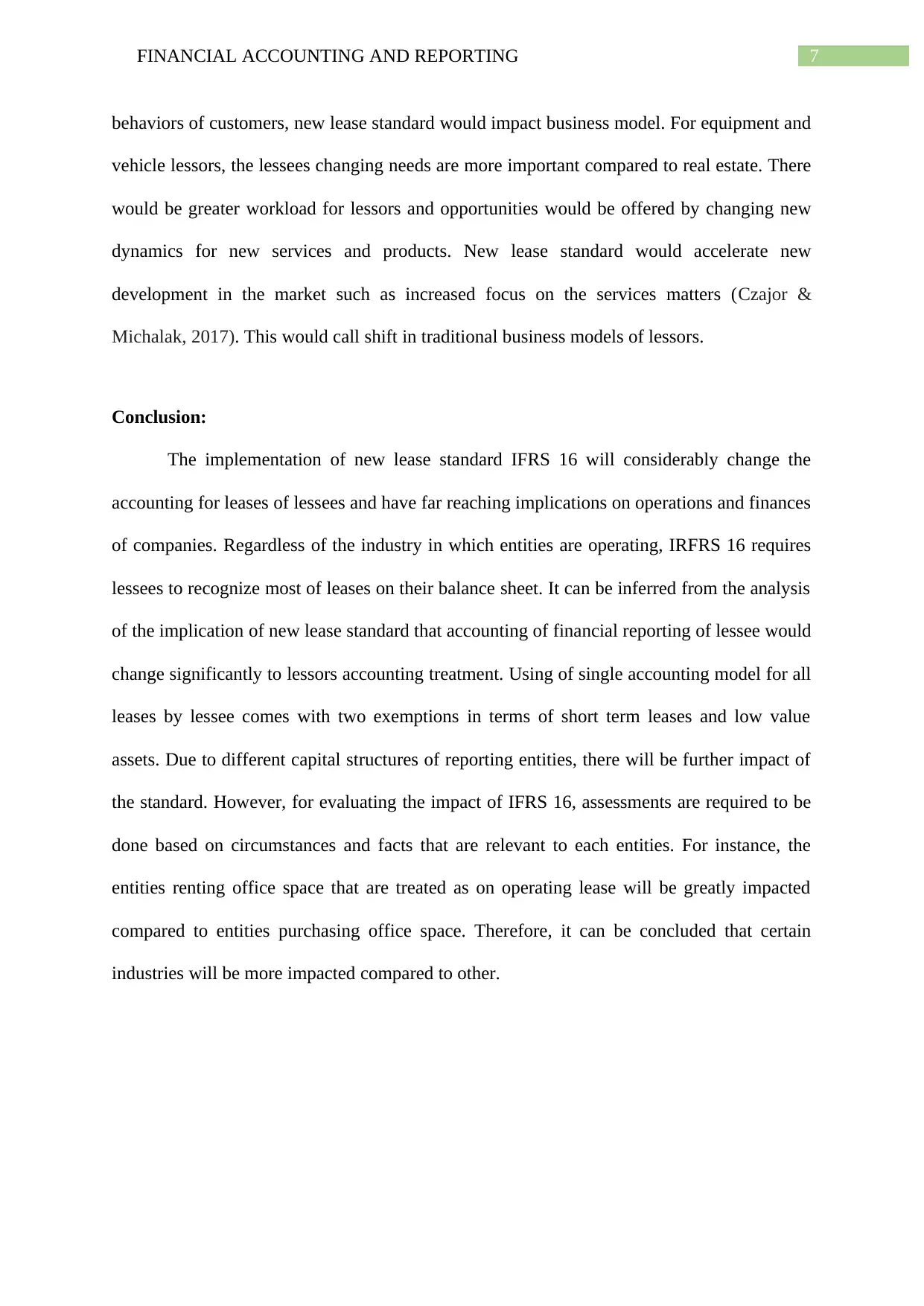
7FINANCIAL ACCOUNTING AND REPORTING
behaviors of customers, new lease standard would impact business model. For equipment and
vehicle lessors, the lessees changing needs are more important compared to real estate. There
would be greater workload for lessors and opportunities would be offered by changing new
dynamics for new services and products. New lease standard would accelerate new
development in the market such as increased focus on the services matters (Czajor &
Michalak, 2017). This would call shift in traditional business models of lessors.
Conclusion:
The implementation of new lease standard IFRS 16 will considerably change the
accounting for leases of lessees and have far reaching implications on operations and finances
of companies. Regardless of the industry in which entities are operating, IRFRS 16 requires
lessees to recognize most of leases on their balance sheet. It can be inferred from the analysis
of the implication of new lease standard that accounting of financial reporting of lessee would
change significantly to lessors accounting treatment. Using of single accounting model for all
leases by lessee comes with two exemptions in terms of short term leases and low value
assets. Due to different capital structures of reporting entities, there will be further impact of
the standard. However, for evaluating the impact of IFRS 16, assessments are required to be
done based on circumstances and facts that are relevant to each entities. For instance, the
entities renting office space that are treated as on operating lease will be greatly impacted
compared to entities purchasing office space. Therefore, it can be concluded that certain
industries will be more impacted compared to other.
behaviors of customers, new lease standard would impact business model. For equipment and
vehicle lessors, the lessees changing needs are more important compared to real estate. There
would be greater workload for lessors and opportunities would be offered by changing new
dynamics for new services and products. New lease standard would accelerate new
development in the market such as increased focus on the services matters (Czajor &
Michalak, 2017). This would call shift in traditional business models of lessors.
Conclusion:
The implementation of new lease standard IFRS 16 will considerably change the
accounting for leases of lessees and have far reaching implications on operations and finances
of companies. Regardless of the industry in which entities are operating, IRFRS 16 requires
lessees to recognize most of leases on their balance sheet. It can be inferred from the analysis
of the implication of new lease standard that accounting of financial reporting of lessee would
change significantly to lessors accounting treatment. Using of single accounting model for all
leases by lessee comes with two exemptions in terms of short term leases and low value
assets. Due to different capital structures of reporting entities, there will be further impact of
the standard. However, for evaluating the impact of IFRS 16, assessments are required to be
done based on circumstances and facts that are relevant to each entities. For instance, the
entities renting office space that are treated as on operating lease will be greatly impacted
compared to entities purchasing office space. Therefore, it can be concluded that certain
industries will be more impacted compared to other.
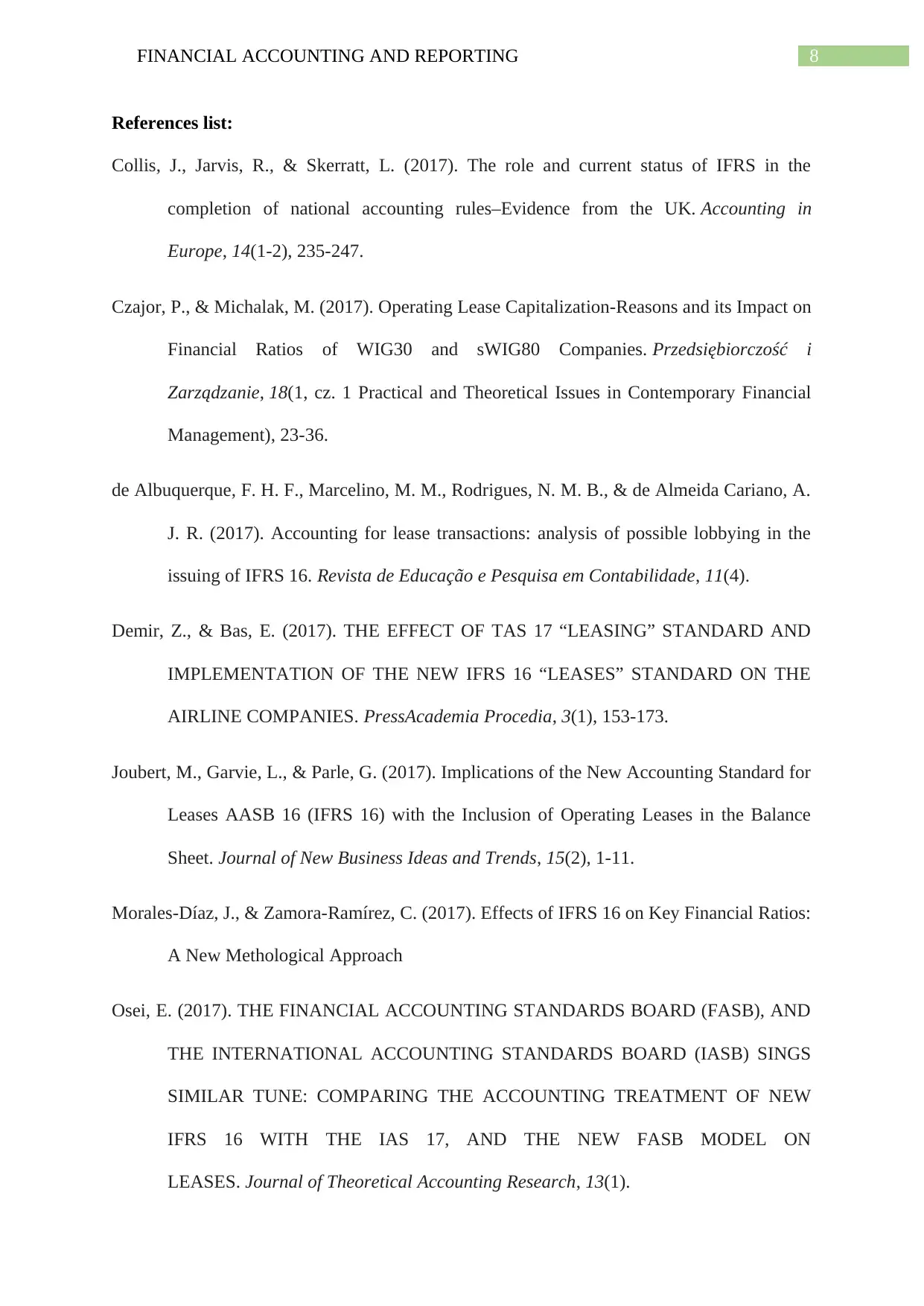
8FINANCIAL ACCOUNTING AND REPORTING
References list:
Collis, J., Jarvis, R., & Skerratt, L. (2017). The role and current status of IFRS in the
completion of national accounting rules–Evidence from the UK. Accounting in
Europe, 14(1-2), 235-247.
Czajor, P., & Michalak, M. (2017). Operating Lease Capitalization-Reasons and its Impact on
Financial Ratios of WIG30 and sWIG80 Companies. Przedsiębiorczość i
Zarządzanie, 18(1, cz. 1 Practical and Theoretical Issues in Contemporary Financial
Management), 23-36.
de Albuquerque, F. H. F., Marcelino, M. M., Rodrigues, N. M. B., & de Almeida Cariano, A.
J. R. (2017). Accounting for lease transactions: analysis of possible lobbying in the
issuing of IFRS 16. Revista de Educação e Pesquisa em Contabilidade, 11(4).
Demir, Z., & Bas, E. (2017). THE EFFECT OF TAS 17 “LEASING” STANDARD AND
IMPLEMENTATION OF THE NEW IFRS 16 “LEASES” STANDARD ON THE
AIRLINE COMPANIES. PressAcademia Procedia, 3(1), 153-173.
Joubert, M., Garvie, L., & Parle, G. (2017). Implications of the New Accounting Standard for
Leases AASB 16 (IFRS 16) with the Inclusion of Operating Leases in the Balance
Sheet. Journal of New Business Ideas and Trends, 15(2), 1-11.
Morales-Díaz, J., & Zamora-Ramírez, C. (2017). Effects of IFRS 16 on Key Financial Ratios:
A New Methological Approach
Osei, E. (2017). THE FINANCIAL ACCOUNTING STANDARDS BOARD (FASB), AND
THE INTERNATIONAL ACCOUNTING STANDARDS BOARD (IASB) SINGS
SIMILAR TUNE: COMPARING THE ACCOUNTING TREATMENT OF NEW
IFRS 16 WITH THE IAS 17, AND THE NEW FASB MODEL ON
LEASES. Journal of Theoretical Accounting Research, 13(1).
References list:
Collis, J., Jarvis, R., & Skerratt, L. (2017). The role and current status of IFRS in the
completion of national accounting rules–Evidence from the UK. Accounting in
Europe, 14(1-2), 235-247.
Czajor, P., & Michalak, M. (2017). Operating Lease Capitalization-Reasons and its Impact on
Financial Ratios of WIG30 and sWIG80 Companies. Przedsiębiorczość i
Zarządzanie, 18(1, cz. 1 Practical and Theoretical Issues in Contemporary Financial
Management), 23-36.
de Albuquerque, F. H. F., Marcelino, M. M., Rodrigues, N. M. B., & de Almeida Cariano, A.
J. R. (2017). Accounting for lease transactions: analysis of possible lobbying in the
issuing of IFRS 16. Revista de Educação e Pesquisa em Contabilidade, 11(4).
Demir, Z., & Bas, E. (2017). THE EFFECT OF TAS 17 “LEASING” STANDARD AND
IMPLEMENTATION OF THE NEW IFRS 16 “LEASES” STANDARD ON THE
AIRLINE COMPANIES. PressAcademia Procedia, 3(1), 153-173.
Joubert, M., Garvie, L., & Parle, G. (2017). Implications of the New Accounting Standard for
Leases AASB 16 (IFRS 16) with the Inclusion of Operating Leases in the Balance
Sheet. Journal of New Business Ideas and Trends, 15(2), 1-11.
Morales-Díaz, J., & Zamora-Ramírez, C. (2017). Effects of IFRS 16 on Key Financial Ratios:
A New Methological Approach
Osei, E. (2017). THE FINANCIAL ACCOUNTING STANDARDS BOARD (FASB), AND
THE INTERNATIONAL ACCOUNTING STANDARDS BOARD (IASB) SINGS
SIMILAR TUNE: COMPARING THE ACCOUNTING TREATMENT OF NEW
IFRS 16 WITH THE IAS 17, AND THE NEW FASB MODEL ON
LEASES. Journal of Theoretical Accounting Research, 13(1).
⊘ This is a preview!⊘
Do you want full access?
Subscribe today to unlock all pages.

Trusted by 1+ million students worldwide

9FINANCIAL ACCOUNTING AND REPORTING
Sacarin, M. (2017). IFRS 16 “Leases”–consequences on the financial statements and
financial indicators. Audit Financiar, 15(145), 114-122.
Zeghal, D., & Lahmar, Z. (2016). The Impact of IFRS Adoption on Accounting
Conservatism in the European Union. International Journal of Accounting and
Financial Reporting, 6(1), 127-160.
Sacarin, M. (2017). IFRS 16 “Leases”–consequences on the financial statements and
financial indicators. Audit Financiar, 15(145), 114-122.
Zeghal, D., & Lahmar, Z. (2016). The Impact of IFRS Adoption on Accounting
Conservatism in the European Union. International Journal of Accounting and
Financial Reporting, 6(1), 127-160.
1 out of 10
Related Documents
Your All-in-One AI-Powered Toolkit for Academic Success.
+13062052269
info@desklib.com
Available 24*7 on WhatsApp / Email
![[object Object]](/_next/static/media/star-bottom.7253800d.svg)
Unlock your academic potential
Copyright © 2020–2025 A2Z Services. All Rights Reserved. Developed and managed by ZUCOL.





